We’ve all been there – staring at empty glass bottles wondering if we should toss them or find a creative purpose. What if we told you these forgotten containers could become stunning botanical masterpieces that’ll transform your living space? Plants in bottles aren’t just trendy décor; they’re miniature ecosystems that bring life to any corner of your home.
Creating your own bottle garden opens up endless possibilities for showcasing your favorite plants while adding a unique touch to your interior design. From sleek wine bottles housing trailing pothos to vintage mason jars filled with colorful succulents, these living art pieces require minimal maintenance while delivering maximum visual impact.
Whether you’re a seasoned plant parent or just starting your green journey, bottle gardening offers an accessible way to experiment with different plant combinations and create conversation-starting displays. We’ll show you how to turn ordinary glass containers into extraordinary botanical showcases that’ll have your guests asking for your secret.
Succulent Terrariums in Glass Bottles
Succulent bottle terrariums offer the perfect blend of low maintenance gardening and artistic display. These drought-resistant plants thrive in enclosed glass environments while creating stunning visual focal points for any space.
Choosing the Right Bottle Size
Wide-mouth bottles work best for succulent terrariums since they provide easy access for planting and maintenance. We recommend using containers with openings at least 4 inches in diameter to accommodate root systems and allow for proper air circulation.
Large glass bottles like gallon-sized pickle jars or wide mason jars offer ample space for multiple succulent varieties. Medium bottles work well for single statement plants like echeveria or jade plants. Small bottles under 6 inches tall should house only the tiniest succulents such as string of pearls or baby tears.
Consider the bottle’s shape when selecting your container. Round bottles provide 360-degree viewing angles while tall cylindrical bottles create dramatic vertical displays. Square or rectangular bottles maximize planting space and fit perfectly on shelves or windowsills.
Best Succulent Varieties for Bottles
Compact succulents adapt beautifully to bottle environments due to their naturally small growth habits. Haworthia varieties like zebra plant and pearl plant stay under 3 inches tall while producing attractive rosette patterns.
Echeveria species including hens and chicks create colorful displays with their blue-green or purple-tinted leaves. These rosette-forming succulents rarely exceed 4 inches in diameter making them ideal for medium-sized bottles.
Jade plants work exceptionally well in larger bottles since they develop thick stems and glossy leaves that create tree-like miniature landscapes. String of hearts adds trailing elements when planted near bottle edges allowing the vines to cascade down the glass sides.
Small aloe varieties such as aloe brevifolia or aloe haworthioides provide architectural interest with their pointed leaves and compact growth patterns. Lithops or living stones offer unique textures and colors while requiring minimal space in bottle gardens.
Creating Proper Drainage Systems
Layered drainage prevents root rot by managing excess moisture in closed bottle systems. We start with a 1-2 inch layer of small pebbles or aquarium gravel at the bottom of each bottle.
Activated charcoal comes next in a thin quarter-inch layer to filter water and prevent bacterial growth. This natural filtration system keeps the bottle environment healthy for extended periods without maintenance.
Sphagnum moss creates a barrier between the charcoal and soil layers preventing soil particles from settling into the drainage materials. Use just enough moss to cover the charcoal layer completely.
Well-draining succulent soil mix forms the final growing medium layer. We prefer cactus potting mix combined with extra perlite to ensure optimal drainage. The soil layer should be deep enough to accommodate root systems while leaving space for plant growth and visual appeal.
Herb Gardens in Repurposed Wine Bottles
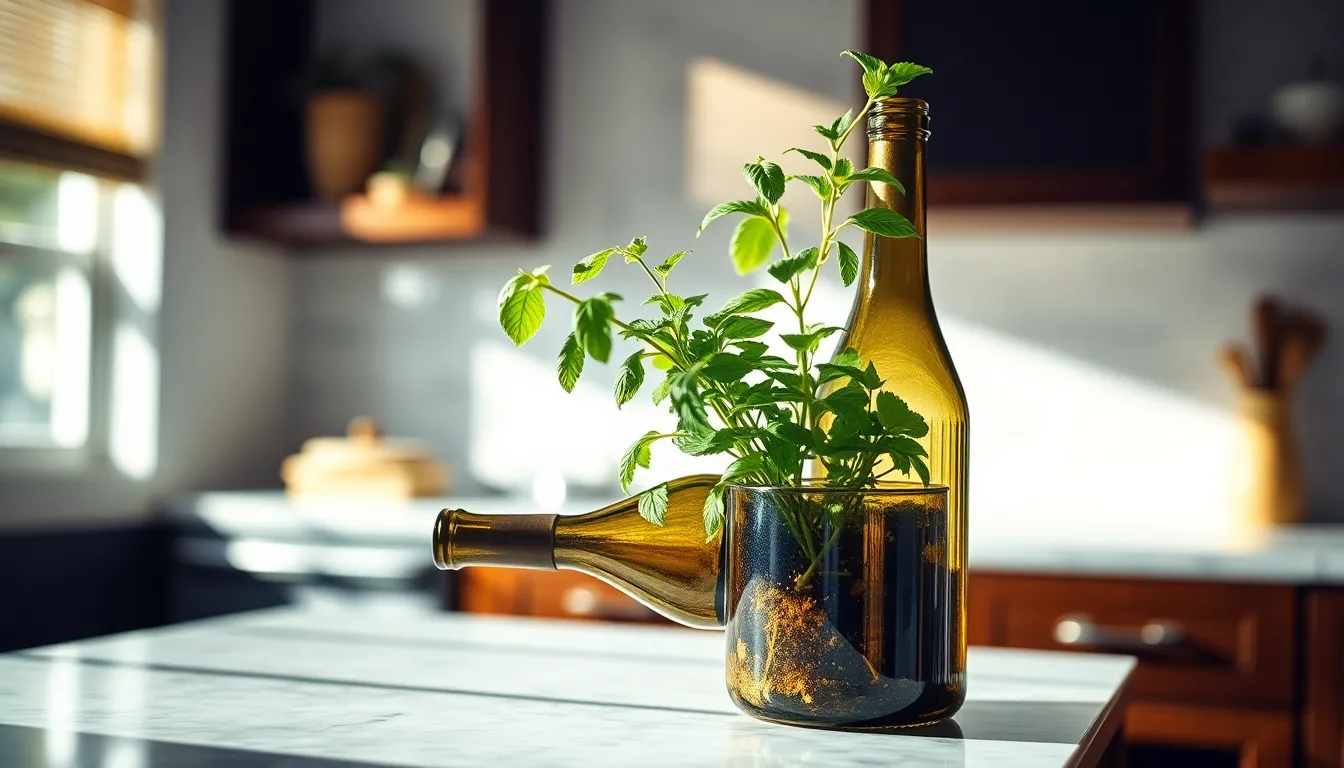
Wine bottles make excellent planters for fresh herbs while giving new life to glass containers that would otherwise be discarded. We’ll transform ordinary wine bottles into functional herb gardens that provide fresh ingredients for your kitchen while adding charm to your living space.
Cutting and Preparing Wine Bottles
Scoring the bottle creates the foundation for a clean cut that transforms your wine bottle into a planter. We recommend using a bottle cutter tool or creating a simple jig to mark the cutting line where you want the bottle to separate.
Heating and cooling techniques help achieve the cleanest break along your scored line. Pour hot water along the score mark, then immediately follow with cold water to create thermal shock that splits the glass precisely.
Sanding the cut edges prevents injuries and creates smooth surfaces safe for handling. We suggest using medium-grit sandpaper to remove sharp edges, followed by fine-grit paper for a polished finish.
Horizontal cuts work best for traditional planters that sit on surfaces, while vertical cuts create hanging garden options. Wine corks from your bottles can serve as drainage plugs or decorative elements in your finished herb garden.
Top Herbs That Thrive in Bottles
Basil adapts perfectly to bottle environments and provides continuous harvests when regularly pinched. This aromatic herb thrives in the limited soil volume that wine bottles offer.
Mint spreads vigorously in confined spaces, making bottle planters ideal for controlling its growth. We’ve found that mint varieties like spearmint and peppermint flourish in these containers.
Thyme requires minimal space and tolerates the drainage limitations of bottle gardens. Its compact growth habit makes it perfect for smaller wine bottle planters.
Parsley grows steadily in bottle containers and provides fresh leaves for months. Both flat-leaf and curly varieties adapt well to the confined growing space.
Cilantro produces fresh leaves quickly in bottle planters before eventually bolting to seed. We recommend successive plantings every few weeks for continuous harvests.
Chives develop into neat clumps that fit perfectly within wine bottle dimensions. Their grass-like growth pattern works exceptionally well in narrow bottle openings.
Watering and Maintenance Tips
Self-watering systems prevent overwatering by using the inverted bottle top method with a string wick. Thread cotton string through the bottle neck to draw water from the bottom reservoir up to the soil level.
Potting soil selection impacts drainage and root health in confined bottle spaces. We recommend herb-exact potting mixes that drain well while retaining enough moisture for healthy growth.
Drainage layers using small pebbles or broken pottery pieces prevent water from pooling at the bottom. Place these materials in the base before adding soil to create proper water flow.
Indirect sunlight for 4-6 hours daily provides optimal growing conditions without overheating the glass container. Position your bottle herb gardens near windows that receive morning or late afternoon light.
Regular pinching encourages bushy growth and prevents herbs from becoming tall and spindly. We suggest harvesting leaves frequently to maintain compact, productive plants in your bottle gardens.
Water monitoring becomes crucial since bottle planters retain moisture longer than traditional pots. Check soil moisture by inserting your finger into the soil before watering to prevent root rot.
Air Plant Displays in Hanging Bottles
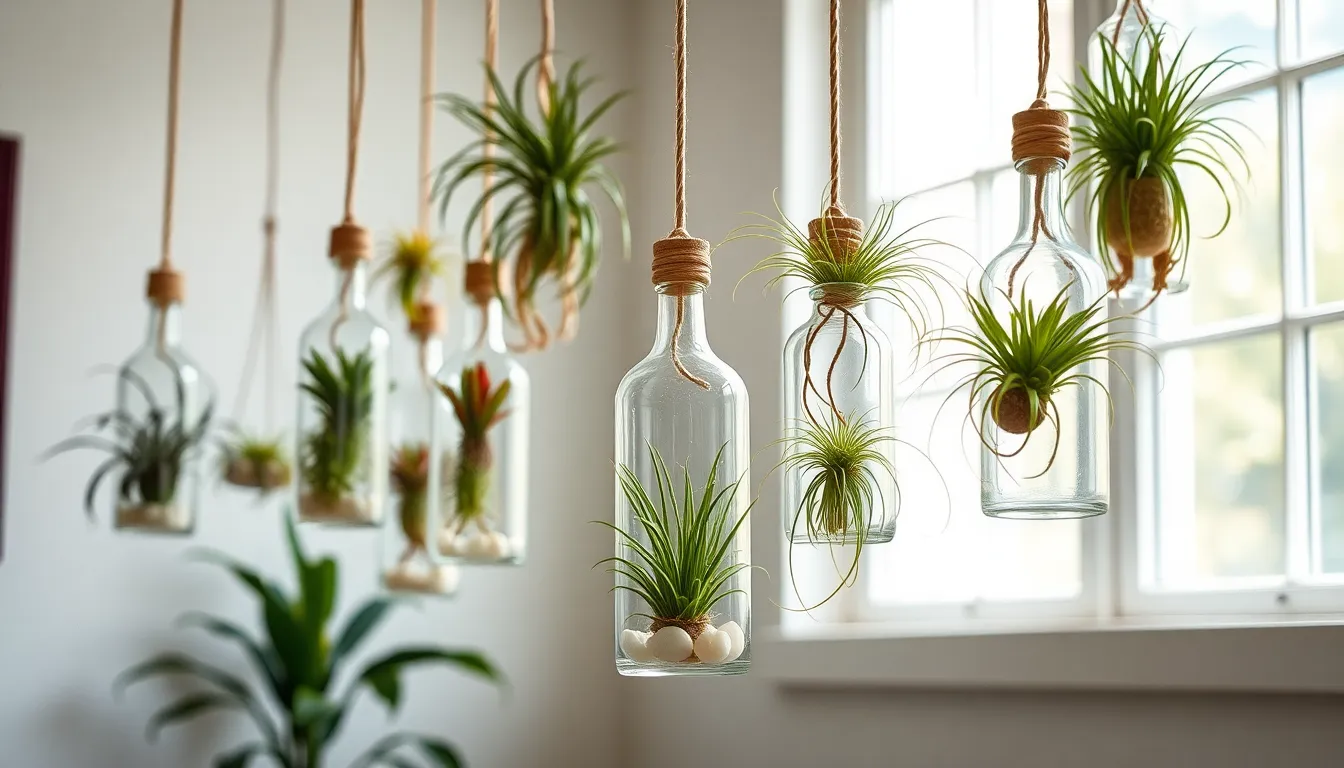
Air plants offer a unique twist on bottle gardening by eliminating the need for soil entirely. These suspended displays create stunning visual effects while providing the excellent airflow that air plants require to thrive.
Selecting Appropriate Air Plant Species
Tillandsia species are perfect for bottle displays because they absorb moisture and nutrients directly from the air. We recommend Tillandsia xerographica and Tillandsia tectorum for their attractive spiral forms and manageable sizes that fit beautifully in small containers. These varieties tolerate enclosed environments better than other species and thrive with minimal care requirements.
Choose air plants that complement your bottle size and shape. Smaller varieties work well in narrow bottles, while larger specimens need wider openings for proper placement. Consider the plant’s growth pattern to ensure it won’t outgrow its container too quickly.
Creating Suspended Bottle Gardens
Start with clear glass bottles or globes that have wide openings for easy air plant placement. Clean the containers thoroughly and ensure they’re completely dry before adding any materials.
Fill the bottom with decorative elements like soft glass pebbles, sea glass, or moss to create a natural textured base. These materials not only enhance visual appeal but also provide elevation for the air plant above any moisture that might collect.
Place white reindeer moss or similar materials as a foundation layer before positioning your air plant. This creates a natural looking arrangement that mimics the plant’s epiphytic nature in the wild.
Attach suspension materials like wire, mesh, or strong string securely to the bottle neck. We prefer using decorative wire or macrame techniques that add to the overall aesthetic while providing reliable support.
Position the air plant carefully on the moss substrate, ensuring it’s not sitting in any standing water. The plant should rest comfortably without being cramped against the bottle walls.
Lighting Requirements for Air Plants
Bright indirect light is essential for air plants in bottles, as direct sunlight can overheat glass containers and damage the plants. East or west facing windows provide ideal lighting conditions throughout the day.
Avoid direct sun exposure which can create a greenhouse effect inside the bottle, leading to overheating and plant stress. We’ve found that filtered artificial light works well as an alternative when natural light is limited.
Monitor humidity levels carefully since bottles can limit airflow and increase moisture retention. Add minimal water inside bottles only in very dry environments, allowing it to evaporate and create beneficial humidity.
Ensure proper ventilation by choosing bottles with adequate openings and avoiding completely sealed containers. Mist the plants regularly rather than relying solely on enclosed humidity to prevent rot and maintain healthy growth.
Moss Gardens in Clear Glass Containers
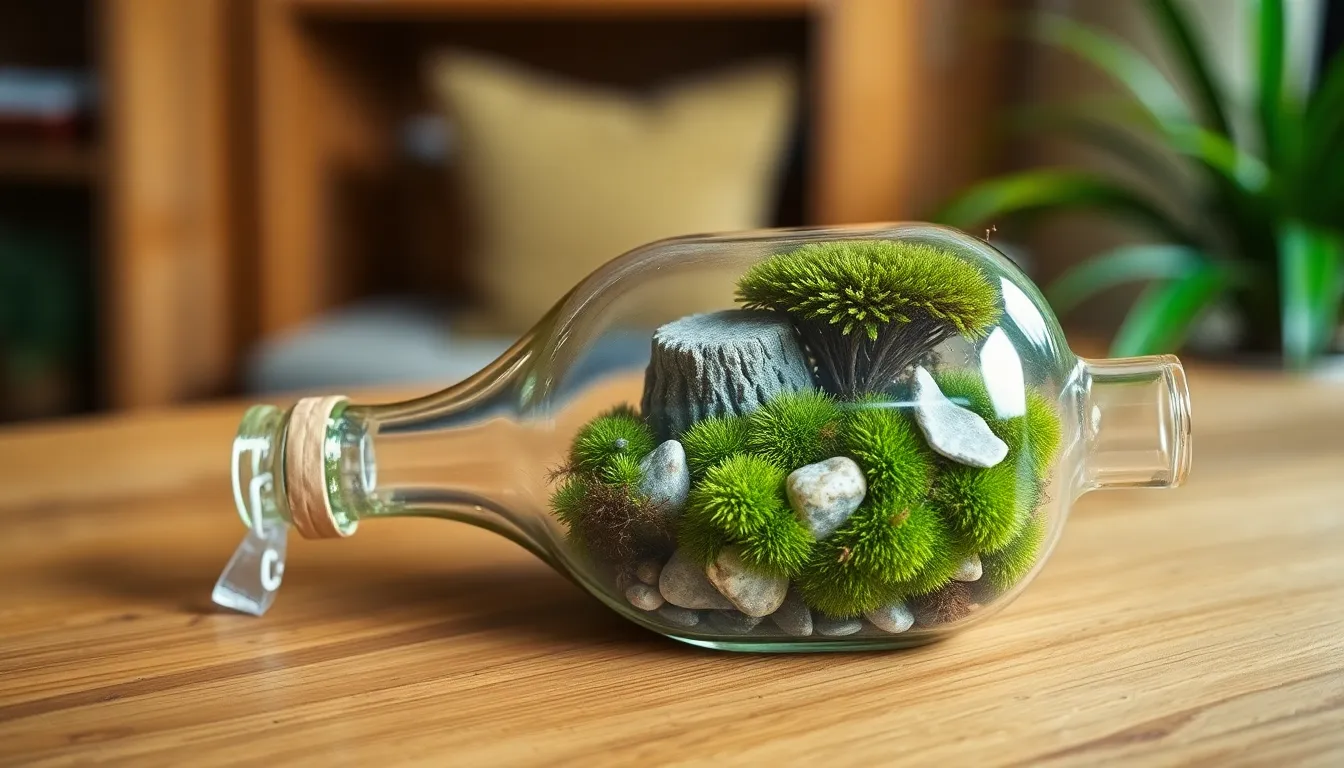
Creating moss gardens in clear glass bottles transforms ordinary containers into enchanting miniature ecosystems that require minimal maintenance. These self-contained gardens showcase the delicate beauty of moss while providing an excellent introduction to terrarium gardening.
Types of Moss for Bottle Gardens
Live moss with roots offers the best foundation for thriving bottle gardens, as it continues growing and maintains the network’s natural balance. Preserved dried moss lacks the vitality needed for long-term success in these enclosed environments.
Sheet moss creates a lush carpet effect that covers surfaces beautifully in glass containers. Cushion moss forms attractive rounded clumps that add texture and visual interest to your miniature industry. Mood moss provides a velvety appearance that enhances the overall aesthetic of your bottle garden.
Garden centers and online retailers stock various moss species specifically suited for terrarium environments. Collecting moss from your own garden presents another option, though we recommend choosing specimens that appear healthy and vibrant. These varieties thrive in the humid conditions that develop naturally inside closed glass containers.
Building Miniature Moss Landscapes
Drainage layers form the foundation of successful moss bottle gardens, preventing water accumulation that leads to root rot. Small rocks or pebbles create an effective drainage system when placed at the bottom of your chosen container.
Activated charcoal layers help maintain fresh air quality and prevent mold growth in closed bottle environments. Potting soil provides essential nutrients for moss growth when layered above the charcoal and drainage materials.
Placement techniques vary depending on your bottle’s opening size and design. Narrow neck bottles require tools like chopsticks or tweezers to position moss pieces accurately through the small opening. Wide mouthed jars allow direct placement of moss specimens without specialized equipment.
Orientation matters significantly for moss establishment in bottle gardens. Position moss pieces right side up and gently tamp them down to ensure proper contact with the soil layer. Miniature accessories like small stones, tiny figurines, or other decorative elements enhance the industry’s visual appeal.
Maintaining Humidity Levels
Closed containers naturally trap moisture, creating the humid environment that moss requires for healthy growth. This self-regulating system reduces the need for frequent watering interventions.
Spritzing water occasionally maintains optimal moisture levels without oversaturating the moss or soil. Monitor the container’s interior for signs of excessive moisture, such as constant condensation or mold development.
Regular observation helps determine when additional misting becomes necessary. Very small containers and open designs require more frequent attention to prevent the moss from drying out completely. Proper humidity balance ensures your moss garden thrives while avoiding common problems like rot or fungal growth.
Water Plants in Large Glass Bottles
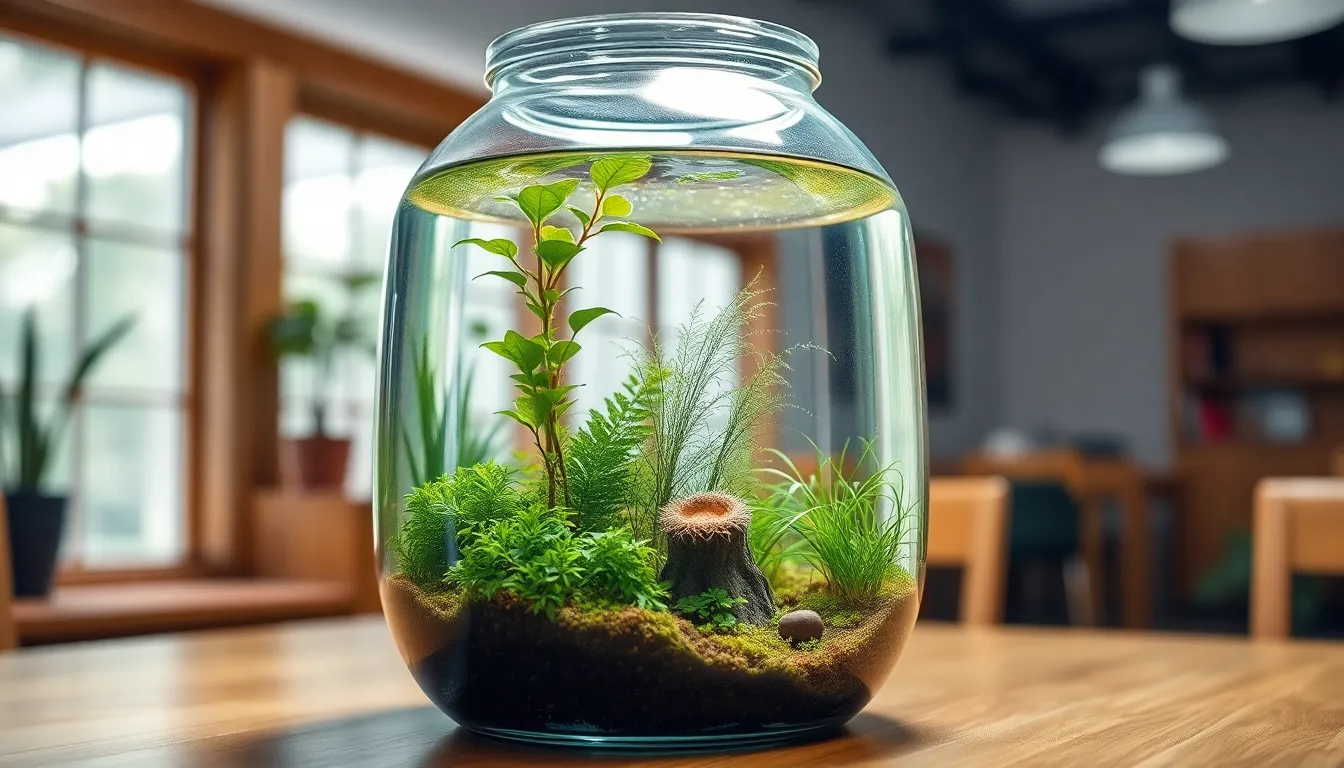
Creating aquatic bottle gardens opens up fascinating possibilities for underwater plant displays that function as self-contained ecosystems. These large glass containers provide enough space for submerged plants to establish thriving miniature aquatic habitats with minimal maintenance requirements.
Aquatic Plants Perfect for Bottles
Java moss tops our list of recommended aquatic plants for bottle ecosystems due to its exceptional adaptability to limited light and space conditions. This hardy plant creates beautiful green carpets that require virtually no maintenance once established.
Anacharis (Elodea) works wonderfully in bottle gardens because it oxygenates the water naturally while growing in fully submerged conditions. We’ve found this plant particularly effective at maintaining water quality in closed bottle systems.
Dwarf sagittaria offers an excellent choice for adding vertical interest to bottle aquascapes since it grows in neat, grass-like clusters. Its compact size makes it perfect for the confined space of glass bottles.
Hornwort provides exceptional filtration benefits while thriving in the low-light conditions typical of bottle gardens. This feathery plant floats freely or can be anchored in substrate, giving us flexibility in design.
Setting Up Underwater Ecosystems
Clean the bottle thoroughly before beginning setup to prevent contamination by harmful fungi or bacteria that could disrupt the network. We recommend using a diluted bleach solution followed by thorough rinsing.
Add substrate layers starting with gravel or sand at the bottom to provide anchoring points for plant roots. A two-inch layer typically provides adequate depth for most aquatic plants.
Include activated charcoal above the substrate layer to maintain water freshness and reduce potential odors in the closed system. This filtration layer proves essential for long-term network health.
Fill with dechlorinated water slowly to avoid disturbing the substrate layers we’ve carefully arranged. Pouring water over a spoon or plate helps minimize substrate displacement.
Plant aquatic species gently into the prepared substrate, ensuring roots make good contact with the growing medium. We position taller plants toward the back and shorter varieties in front for optimal visual appeal.
Position away from direct sunlight to prevent overheating and algal blooms that can quickly overwhelm the delicate network balance. Indirect light or artificial plant lights work best for these setups.
Caring for Submerged Plant Life
Monitor water levels regularly and top off with fresh, dechlorinated water as needed without flooding the system. We’ve found that most bottle ecosystems need water additions every 2-3 weeks.
Avoid direct sunlight exposure which can cause rapid temperature fluctuations and promote unwanted algae growth. Consistent, indirect lighting maintains the healthiest underwater environment.
Remove decaying plant material promptly to prevent fungal infections that can spread throughout the contained network. We inspect our bottle gardens weekly for any signs of plant deterioration.
Add liquid plant fertilizer occasionally in very small amounts since enclosed bottles lack the natural nutrient cycling found in soil-based systems. A few drops of aquatic plant food monthly typically suffices.
Maintain container cleanliness by preventing contaminants from entering during maintenance activities. We use clean tools and avoid introducing soap residues or other chemicals that could harm the aquatic plants.
Miniature Fairy Gardens in Bottles
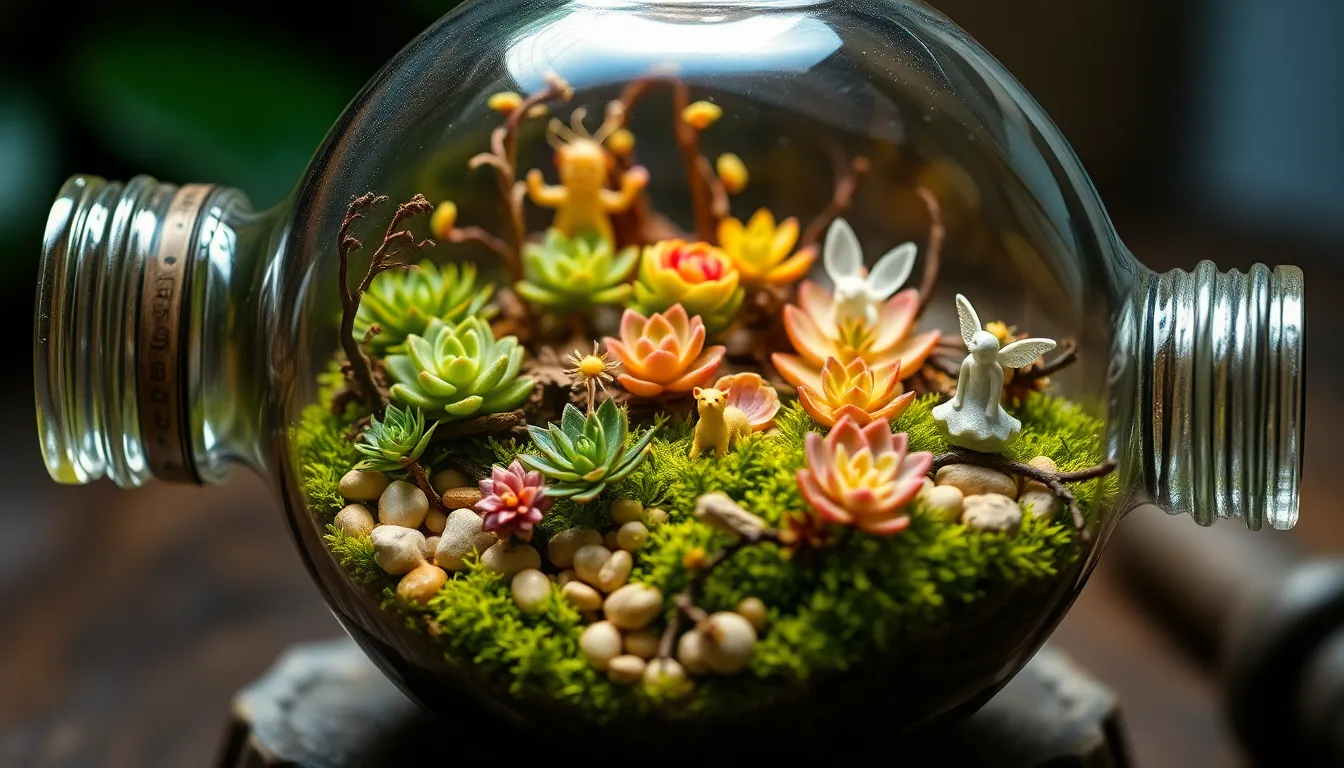
Transitioning from traditional plant displays, we can transform bottles into enchanting miniature worlds that capture imagination and spark wonder. These tiny ecosystems combine living plants with decorative elements to create magical scenes that tell stories within glass confines.
Creating Whimsical Bottle Scenes
Building your fairy garden foundation starts with proper layering techniques that ensure both drainage and visual appeal. We recommend placing small rocks or pebbles at the bottom first, creating a drainage system that prevents water from pooling around plant roots. Adding soil and moss creates the perfect base layer that supports plant life while establishing the natural groundwork for your miniature industry.
Incorporating natural textures brings authenticity to your bottle scenes through carefully selected organic materials. Small twigs, seed pods, and grapevines add dimensional interest and create realistic miniature environments that mirror full scale gardens. These elements provide structure for climbing plants and create natural pathways throughout your bottle network.
Layering different materials at varying heights creates depth and visual interest within the confined bottle space. We suggest using different sized pebbles, various soil types, and multiple moss varieties to establish distinct zones within your fairy garden. Strategic placement of natural elements guides the eye through your miniature industry and creates focal points that draw attention.
Adding Decorative Elements and Figurines
Selecting waterproof figurines ensures your decorative elements withstand the humid terrarium environment without deteriorating over time. Resin or fired clay figurines work exceptionally well inside bottles because they resist moisture damage while maintaining their vibrant colors and intricate details. These materials prove essential for creating long lasting fairy garden displays that remain beautiful for months.
Crafting miniature accessories from everyday materials adds personal touches that make each bottle garden unique and charming. Small handcrafted items like mini baskets made from bottle caps or burlap trims provide scale appropriate details that enhance the storytelling aspect of your garden. DIY plastic bottle fairy houses formed with clay detailing offer customizable shelter options for your miniature inhabitants.
Choosing thematic figurines creates cohesive scenes that transport viewers into your miniature industry through careful storytelling. Whimsical fairies, tiny animals, and miniature houses work together to establish an enchanting atmosphere that captures both children’s and adults’ imaginations. Strategic placement of these elements throughout your bottle creates natural gathering spots and activity areas within your fairy community.
Plant Selection for Fairy Gardens
Choosing slow growing, compact plants ensures your bottle garden maintains proper proportions without requiring frequent maintenance or replanting. We recommend focusing on species that naturally stay small and thrive in confined spaces with limited root room. These characteristics prevent overcrowding and maintain the delicate balance of your miniature network.
Selecting succulents like Crassula Baby Necklace, Sedum Little Missy, and Sedum dasyphyllum minor provides ideal plants for bottle environments due to their minimal water requirements and naturally compact growth patterns. These varieties adapt well to terrarium conditions while offering diverse textures, colors, and forms that enhance visual interest. Their drought tolerance makes them perfect for closed bottle systems where moisture levels can fluctuate.
Using moss as ground cover creates lush green carpets that tie together all elements of your fairy garden while thriving in terrarium conditions. Moss provides essential humidity regulation and creates realistic forest floor effects that make your miniature scenes appear natural and established. This versatile plant fills gaps between decorative elements and creates smooth transitions throughout your bottle industry.
Incorporating miniature herbs and small ivy varieties expands your plant palette for open terrariums with adequate light exposure. These options provide aromatic elements and trailing growth patterns that add movement and life to your fairy garden scenes. Careful selection based on your bottle’s light conditions ensures healthy plant growth and long term garden success.
Propagation Stations Using Glass Bottles
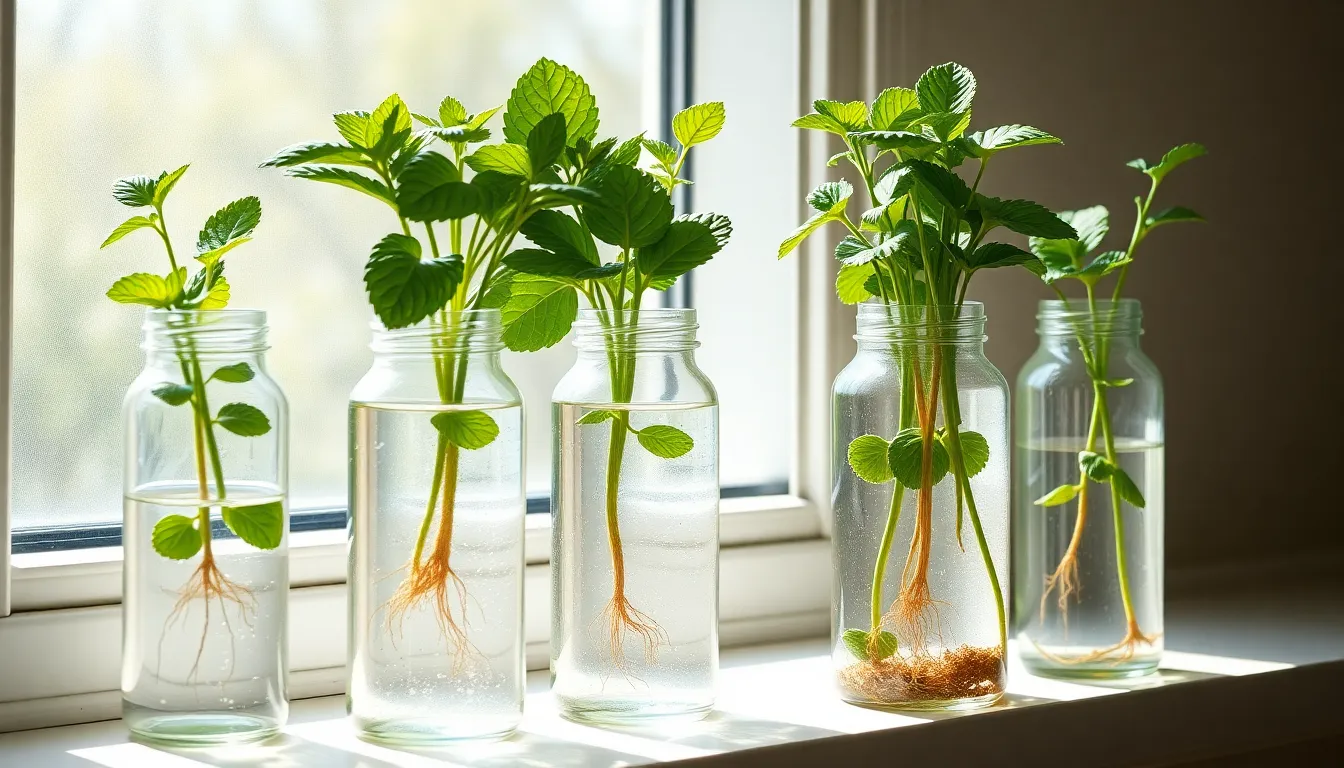
Glass bottles transform into perfect propagation stations that help us grow new plants without investing in expensive equipment. We can create controlled environments that double our rooting success rates compared to traditional methods.
Rooting Cuttings in Water-Filled Bottles
Water propagation becomes incredibly effective when we use clear glass bottles as our rooting vessels. We simply cut a plastic bottle in the middle and reassemble it so the bottom holds water below the cutting tips without fully submerging the stems, which prevents rot. Clear containers allow us to monitor root development easily without disturbing the delicate cutting process.
Mint cuttings root particularly well using this water bottle method, often showing new growth within just a few weeks. We place our bottle setup in indirect light and change the water regularly to maintain oxygen levels and prevent bacterial growth. The transparent walls let us observe the fascinating root development process while maintaining the ideal moisture conditions our cuttings need.
Transitioning Plants from Water to Soil
Moving our rooted cuttings from water to soil requires careful attention to prevent transplant shock. We gradually acclimate plants by keeping them in their bottle mini greenhouse environment for a transitional period before full potting. Loamy soil works best for transplanting because it holds moisture while providing proper drainage that prevents root rot.
Keeping the soil consistently moist but well drained becomes crucial during this vulnerable stage. We maintain humidity levels around our newly transplanted cuttings by covering them with the top half of our propagation bottle for the first week. This gentle transition helps our plants adapt to their new growing medium without experiencing stress.
Best Plants for Propagation Projects
Several plant varieties thrive exceptionally well in our bottle propagation setups throughout spring and summer growing seasons. We achieve the highest success rates with mint, which propagates easily from both root and stem cuttings in water filled bottles. Pothos and philodendrons consistently perform well as water propagation favorites that adapt quickly to bottle environments.
Coleus cuttings develop robust root systems when we maintain proper humidity levels in our bottle stations. Fig cuttings also perform exceptionally well when we keep humidity maintained within our clear bottle enclosures. These plants respond positively to the controlled environment that bottles provide, making them ideal choices for our propagation experiments.
Seasonal Bottle Garden Themes
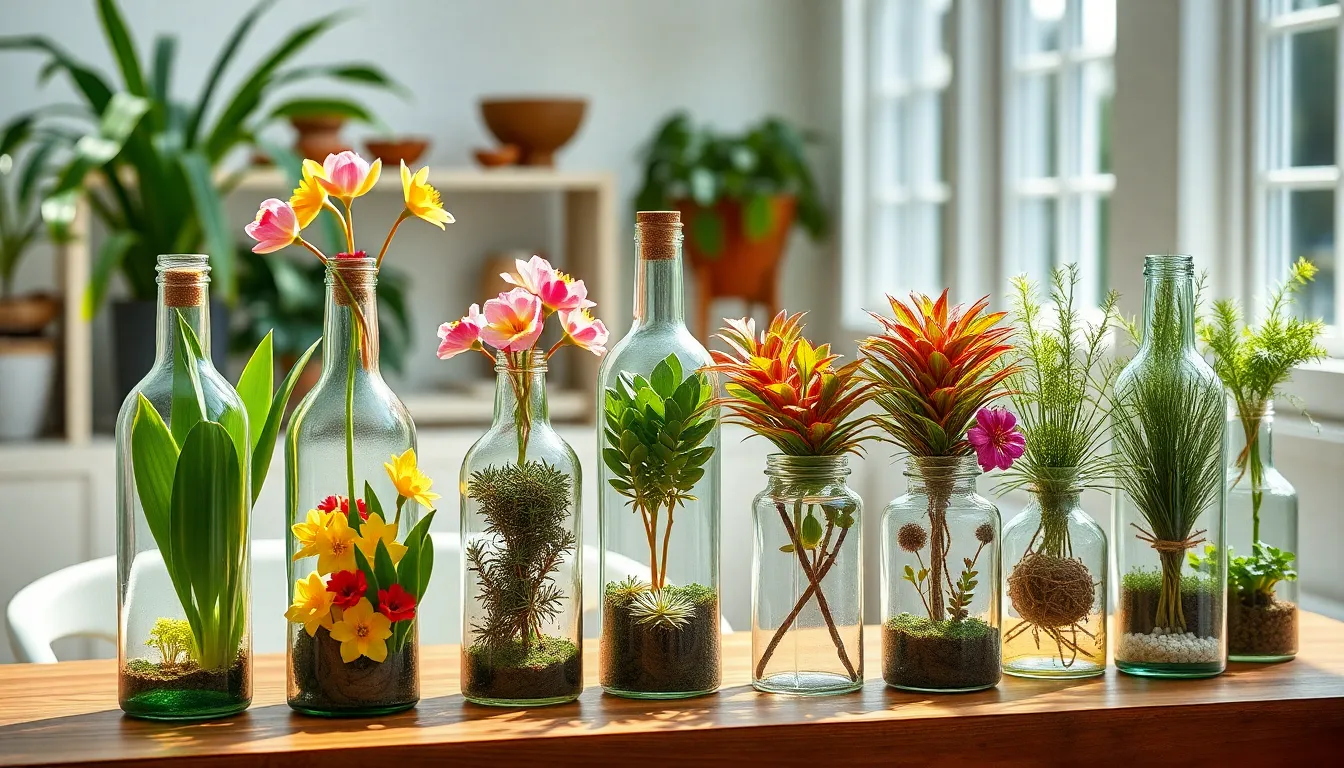
Seasonal bottle gardens let us create displays that evolve throughout the year, bringing fresh colors and textures to our homes with each changing season. We can transform our glass containers into vibrant showcases that celebrate the unique beauty of spring blooms, summer tropicals, and winter evergreens.
Spring Flowering Bulbs in Bottles
Spring bulbs like tulips, daffodils, hyacinths, crocus, muscari, and scilla create stunning displays when planted in glass bottles with proper drainage systems. Container size matters significantly for success: small bottles work perfectly for crocuses and muscari, while midsize containers suit hyacinths best, and larger bottles accommodate tulips and daffodils effectively.
Layering bulbs by depth creates visually appealing arrangements inside clear containers. Larger bulbs like tulips need planting at approximately 5 inches deep, while smaller varieties require less depth for optimal growth. Well-draining soil keeps bulbs moist without becoming soggy, preventing rot and ensuring healthy development.
We can create moveable spring color displays by arranging different bulb varieties in bottle gardens. Multiple bulb types planted together form natural bouquets that bloom at varying times throughout spring. This approach extends the flowering period and provides continuous interest in our seasonal bottle displays.
Summer Tropical Plant Arrangements
Summer tropical arrangements thrive in the warm, humid microclimate that bottle gardens naturally create. Miniature palms, bromeliads, and ferns excel in these conditions, producing lush green displays with colorful foliage during the warmer months. These plants require sufficient light but benefit from the consistent humidity levels that sealed or semi-open bottles provide.
Tropical bottle gardens need warm environments and careful attention to moisture levels. We can combine different tropical species to create varied textures and colors within single containers. Bromeliads add striking architectural forms, while ferns provide delicate, feathery textures that complement bolder tropical plants.
Vibrant summer displays emerge when we select tropical plants with different growth habits and leaf patterns. Combining upright growers with trailing varieties creates ever-changing compositions that use the entire bottle space effectively. These arrangements maintain their appeal throughout the summer growing season.
Fall and Winter Evergreen Displays
Evergreen plants like small pines, junipers, and boxwoods provide year-round structure and beauty in bottle gardens during cooler months. These hardy plants tolerate lower temperatures while maintaining their green color and form throughout fall and winter seasons. We can create lasting displays that remain attractive even when other plants enter dormancy.
Small evergreen varieties work exceptionally well in bottle environments because they grow slowly and maintain compact forms. Junipers offer interesting needle textures and natural bonsai-like shapes, while boxwoods provide dense, refined foliage that looks elegant in glass containers. Pine varieties add vertical interest and classic evergreen appeal.
Winter bottle gardens benefit from evergreen plants that require minimal maintenance during dormant seasons. These displays continue providing visual interest when outdoor gardens lack color and activity. We can enhance evergreen bottles with natural elements like pinecones or decorative stones to create seasonal themes that celebrate winter’s quiet beauty.
Conclusion
We’ve explored countless ways to transform simple glass bottles into thriving miniature ecosystems that bring nature indoors. From low-maintenance succulent displays to enchanting fairy gardens each approach offers its own unique charm and benefits.
The beauty of bottle gardening lies in its accessibility – whether you’re propagating herbs on your kitchen windowsill or creating seasonal displays that evolve throughout the year. These projects require minimal investment while delivering maximum visual impact.
Your bottle garden journey can start small and grow as your confidence builds. We encourage you to experiment with different combinations and discover which styles resonate most with your space and lifestyle. The possibilities are truly endless when you begin seeing every empty bottle as a potential home for living art.
Frequently Asked Questions
What types of glass bottles work best for bottle gardens?
Wide-mouth containers like mason jars and large wine bottles work best for bottle gardens. They provide easy access for planting and maintenance while ensuring proper air circulation. Choose clear glass containers to showcase your plants and allow adequate light penetration for healthy growth.
Which plants are easiest for beginners to grow in bottle gardens?
Succulents like Haworthia, Echeveria, and jade plants are perfect for beginners due to their low-maintenance nature. Air plants (Tillandsia) are also excellent choices since they require no soil and minimal care. These plants are forgiving and adapt well to bottle environments.
How do I create proper drainage in a glass bottle garden?
Layer pebbles at the bottom, followed by activated charcoal, sphagnum moss, and well-draining soil mix. This layered approach prevents root rot by allowing excess water to drain away from plant roots while maintaining proper moisture levels for healthy growth.
Can I grow herbs in repurposed wine bottles?
Yes! Herbs like basil, mint, thyme, parsley, cilantro, and chives thrive in wine bottle gardens. Cut the bottle properly, sand edges for safety, use quality potting soil, and ensure adequate sunlight exposure. These herb gardens provide fresh ingredients while adding charm to your kitchen.
How do I maintain humidity levels in closed bottle gardens?
Monitor moisture by checking for condensation on glass walls. Moss gardens and closed terrariums create their own humid microclimates. Remove the lid occasionally if excessive condensation occurs, and avoid overwatering to prevent mold or rot issues while maintaining optimal growing conditions.
What are air plants and how do I display them in bottles?
Air plants (Tillandsia) are unique plants that require no soil and absorb nutrients from the air. Display them in hanging glass bottles with proper ventilation, avoiding direct sunlight. Species like Tillandsia xerographica work well in bottle displays and need minimal maintenance.
How do I transition water-rooted cuttings to soil?
Gradually acclimate rooted cuttings by reducing water levels slowly before transplanting to soil. This prevents transplant shock and helps roots adapt to their new growing medium. Plants like pothos, philodendrons, and mint propagate successfully using this water-to-soil transition method.
Can I create seasonal themes with bottle gardens?
Absolutely! Use spring flowering bulbs like tulips, summer tropical plants like miniature palms, and evergreen plants like small pines for winter displays. Seasonal bottle gardens allow you to celebrate changing seasons while maintaining year-round indoor greenery and visual interest.







